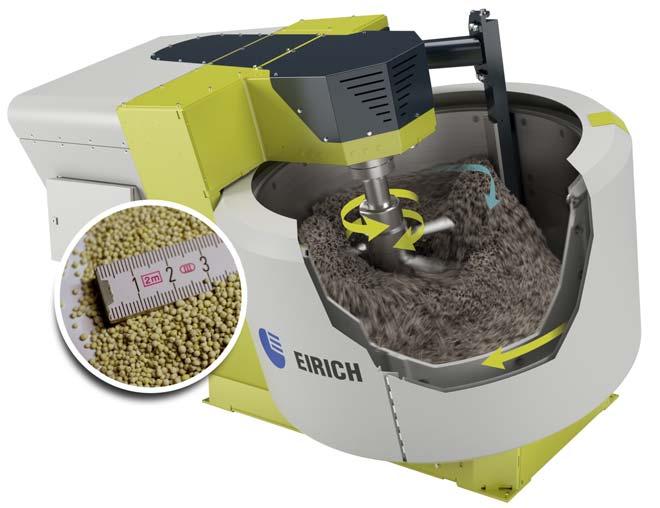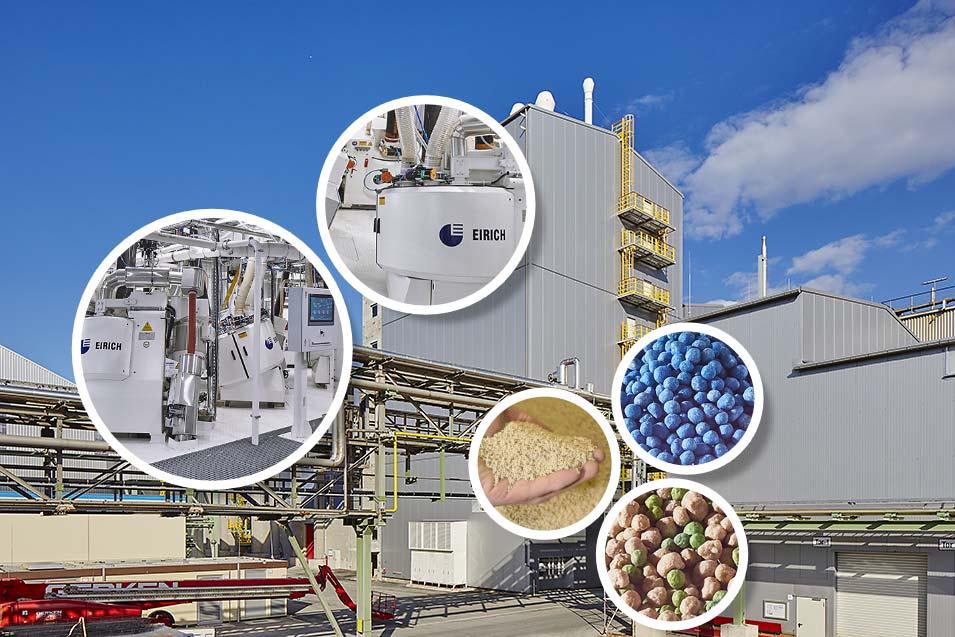
11 minute read
Fertilizer With A Double Twist


FERTILIZER WITH A double double double twist twist twist


Thomas Lansdorf, Eirich, Germany,
provides a number of practical examples to showcase how the range of applications for which fertilizer granules are being manufactured is steadily growing.

The advanced civilisation of the Egyptians is still astounding today. As well as being masters of mathematics and astronomy, they were particularly skilled in the art of architecture and building. But in addition to this, they also worshipped a tiny beetle – Scarabaeus, also known as the sacred scarab beetle, which symbolised resurrection and represented the circular path of the sun in the sky. This is quite a leap of imagination for a tiny beetle otherwise renowned for its ability to roll dung into round balls. But, of course, these balls are incredibly important as they are used as a food source or as breeding chambers for the larvae of the beetle. And in the process, the dung balls are a typical example of an agglomeration granulate that is comparable to fertilizer granulate, as the basic principle behind their production is very similar. The rolling movement in itself is enough to ensure that a round and stable granulate is formed. Of course, fertilizer granules are much smaller, but they are produced in surprisingly large quantities.



Just like the efforts of the scarab beetle, with this type of granulate the correct rolling action is key. What the insect manages with skill and endurance, an EIRICH SmartMixer will deliver consistently as well. The secret is in the double-rotation action. The movement of the pan protects the materials, while the rotor delivers the necessary shear forces. The result is a uniform granulate – in the end, it is all just a matter of the correct speed (Figure 1).
The system can be used to granulate almost any kind of powdery substance. With skilled management of the process, the required granulate can be quickly produced. The key requirement is a large surface area, so it is important that the input materials are fi nely ground. This will ensure that suffi cient adhesion forces for granulation can be generated. Water is commonly used as the wetting fl uid, but additional binding agents can also be used if required.

Figure 1. The SmartMixer fully automates mixing and granulation in a single system.
Figure 2. SmartMixer combined with disk pelletisers. Production of dolomite pellets.

From single machines to a complete line
By using the mixer, raw materials can be mixed, granulated and coated, while chemical reactions can be carried out quickly and completely as required. In many applications, individual processes are combined with each other – for example to produce a homogeneous mixture from fi lter cake, dusts and slurries. Provided the moisture level is correctly adjusted, the desired granules will form within the space of just a few minutes. Larger pellets are often produced using a disk pelletiser or a rolling drum.
Combining individual processes in this way produces a complete fertilizer production plant capable of running around the clock and continuously manufacturing fertilizer to consistently high standards.
Of dolomite, lime and gypsum
Many carbonates and sulfates are compounds that are diffi cult to dissolve. These sedimentary rocks can be found in large quantities all around the world. Their poor solubility is an advantage as it guarantees a slow and continuous release of nutrients. For granulation, the raw materials are broken up, ground down and then granulated. Binding agents and additives are added in the mixer and moistened to produce a homogeneous microgranulate. In a disk pelletiser, these microgranules are then grown into the required pellets (Figure 2). Usually between 5 – 10 mm in size, these pellets are round and highly uniform. After drying they can be packaged and stored. When they come into contact with moisture again in the ground, the granules decompose and release the nutrients in the process. They are normally produced in amounts of 10 to 40 tph. The granules can be stored for many years and are perfect for spreading. All around the world, Eirich production lines have been built for precisely this purpose. For example, one large manufacturer in Poland manufactures a fertilizer granulate from dolomite (Figure 3).
Sulfuric acid – the solution for insoluble minerals
While humans and animals consume organic food, plants love minerals. Some minerals are completely insoluble in water, putting their nutrients beyond the reach of plants. This is why a dissolution stage with acid is required fi rst, which can be achieved quickly and effi ciently by adding sulfuric acid in the mixer. In this way, phosphate ore can be dissolved through the addition of sulfuric acid. Another example is the use of the mineral serpentinite as a fertilizer. Serpentinite is a magnesium silicate that contains many nutrients. The rock is broken up, ground down and then dissolved with sulfuric acid in the mixer. The moist reaction product is formed into granules directly in a disk pelletiser. The minerals can be dissolved in the soil, where they enable maize and grain to grow faster. A RV19 (1500 l) Eirich mixer and a TR36 disk pelletiser have been installed at a modern plant in Paraguay.
Too much of a good thing is bad for you
Of course, materials that are completely insoluble are of no value at all to plants. But conversely, if they are too readily
soluble then this is also bad for the plant. For example, incorrect use of urea will often lead to eutrophication. Solubility can be reduced very easily with the aid of a semi-permeable coating. This can be achieved using polymers, hardly soluble salts or sulfur. In many cases, the coating process needs to be carried out at higher temperatures. Many examples of this type of fully-automated coating process have already been successfully realised. For example, mixers of type RV24 (3000 l) are being used in North America to manufacture a long-term fertilizer from prilled urea.
Granulation of easily soluble salts
Many salts are important components in fertilizer mixtures. Typical salts include potassium chloride (MOP) or potassium sulfate (SOP). Polyhalite, a mineral comprising several sulfates, is also among the individual salts used. The goal is to produce uniform and round granules preferably ranging in size from 2 – 4 mm. Applications in which these salts are to be granulated usually have high throughput rates.
This is why mixers of type R28 (5000 l) or R33 (7000 l) are often used. Eirich has developed various methods for doing this so that the granulating process can be kept cost-effective (Figure 4).
Ammonium sulfate is also an important fertilizer salt. It is produced in large quantities during the production of Nylon 6 and in fl ue gas desulfurisation. A fertilizer factory in Eastern Europe has been producing granules from ammonium sulfate for many years with the aid of mixers manufactured by the company.
Only the best is good enough for football and golf professionals
Football (soccer) and golf are played on some of the lushest grass surfaces in the world. These areas require special care to cope with the challenging demands they are subjected to. As a result, it is vital that the supply of nutrients is optimised to ensure healthy growth. These multi-component fertilizers contain the full range of nutrients in every single granule. In production, the nutrient salts are ground in an Eirich Turbo Grinder, before being weighed, homogenised in a mixer, moistened and granulated. At the end, the granules are dried and coated. One such plant for the production of fertilizer for golf courses is located in Switzerland, while another is located in Krefeld, Germany (Figure 5).
Above all else, good soil is healthy
Every farmer knows that it is not enough to just keep fertilizing the soil. As well as minerals, healthy soil also needs humic acids. These are found abundantly in humus, peat and lignite. A granulate made of humic acids is a valuable supplement for soil treatment. Soils that are compacted, display high salinity or are sandy can be signifi cantly improved with this. Leonardite, a by-product of lignite mining, can be used for this purpose. With the aid of Eirich mixers it is moistened and then granulated. Such a plant operates in Grevenbroich in Germany, where a valuable soil improver is manufactured for reactivating infertile soils.
Plants can suffer stress as well
Anyone who has ever worked in a large, open-fl oor offi ce knows what stress is all about. The hustle and bustle of an environment full of people and noise always puts us under more pressure. Some people may reach for a bar of chocolate to calm their nerves. Plants have to cope with these stress factors as well. Heat, drought, cold, lack of light and replanting are just some of the typical stress situations for plants. But there are also a number of natural protection strategies to help ward off these pressures. For example, substances can be used to stimulate their metabolism. Plants become more resistant and the regeneration phase is shortened so that, at the end,

Figure 3. A production plant in Poland showing the mixing and pelletising of limestone fertilizer.

Figure 4. The SmartMixer R28 (5000 l) is a big and robust mixer for large throughputs, used for mixing and granulating of mineral salts.

Figure 5. A production plant in Krefeld, Germany, showing the mixing and granulating of NPK fertilizer.
yield and quality can be demonstrably improved. Since the active ingredients are applied in small quantities, it makes sense to deliver them with the aid of carrier materials. Eirich is currently constructing a state-of-the-art granulation plant for the production of biostimulants in Sweden. The active ingredient is a derivative of an amino acid, which is granulated together with a mineral carrier material.
Organic fertilizer
The use of natural fertilizer is one of the oldest methods of fertilization. Residues from the digestion of foodstuffs by animals contain many compounds that can be absorbed by plants. These include fermentation residues, nut shells, bone and feather meal, chicken dung, horn shavings and plant fi bres. After mixing, the granules are shaped – usually on a disk pelletiser or in granulating drums. Here, larger fi bres are entangled and form an agglomerate. After drying, this then produces stable pellets. An Eirich mixer has been installed at a plant in Modena in Italy for this purpose, where an RV19 (1500 l capacity) is used to combine organic residues with mineral substances. Afterwards, the mixture is formed into agglomerates in a drum.
Turning ash into something valuable
Ash is usually all that is left over from combustion processes. One example is in Scandinavia, where large quantities are produced during the burning of wood. Of course, this ash is a valuable fertilizer; potash is rich in potassium carbonate and other minerals. In Sweden, the ash is spread as fertilizer in the forests, but this can be a very dusty business. It is much better to use it to produce pellets, which are far easier to handle. Mixers and disk pelletisers from Eirich are used here to manufacture spreadable granules.
All sources are fi nite – recycling is the top priority
Secondary raw materials are becoming increasingly popular as more and more efforts are made to ensure that production is as environmentally friendly as possible and natural resources are used sparingly. Many of these fertilizer raw materials are present as fi lter cakes, slurries or dusts. As a result, suitable processes need to be employed to break down the process residues and mix them with powders or slurries. An RV23 is used for this in Duisburg in Germany to mix a range of different secondary raw materials. Afterwards, the moistened microgranulate is pelletised in an Eirich disk pelletiser of type TR36. The manufactured granules are used in farming.
A cornucopia of possibilities
Our world is in a process of constant change. The prices of raw materials, climate change and the impact of modern living are changing the world every single day. The requirements for fertilizers are also subject to constant change, and it is important that the industry is able to react fl exibly to these challenges. Additive granulation offers almost unlimited options for doing this. Many process steps such as mixing, granulating and coating can be combined to streamline processes, and this is rounded off by controlling the temperature, reaction time and amount of liquid to suit the specifi c requirements.


IBC | Ammonia 2021
04 | Argus Media
09 | Berndorf Band
24 | BEUMER Group
OBC | Central Maintenance & Welding
23 | Chemetics
21 | Comessa
07 | Desmet Ballestra
33 | EMT/Doyle Equipment Manufacturing
AD INDEX
OFC & 17 | Hydro, Inc.
27 | J&H Equipment Inc.
35 | Köppern
14 | Ludman Industries
30 | MoistTech
IFC | Neelam Aqua & Speciality Chem(P) Ltd.
29 | Nel Hydrogen
21, 33, 36 & 43 | Palladian Publications
13 | Sulzer









